Themed collection #MyFirstJMCC

The future of electronic materials is…degradable!
In the last decade, electronic applications have multiplied and thus various materials have been widely used. This study focuses on the last years of degradable/disintegrable electronic materials both as supporting and active materials.

J. Mater. Chem. C, 2023,11, 11803-11813
https://doi.org/10.1039/D3TC01128C
Colloidal III–V quantum dots: a synthetic perspective
III–V QDs are high performing materials, however, their exacting synthesis is a major hurdle hampering widespread adoption. We have compiled the disparate routes to III–V QDs and concisely present them, along with our perspectives for the field.

J. Mater. Chem. C, 2023,11, 3926-3935
https://doi.org/10.1039/D2TC05234B
Recent progress in tuning charge transport in single-molecule junctions by substituents
We summarized the mechanism of substituent influence on single-molecule conductivity into three aspects: the quantum interference effect, the electronic effect of substituents and the conformational restriction of the conductive backbone.

J. Mater. Chem. C, 2023,11, 14515-14526
https://doi.org/10.1039/D3TC02035E
Robust electron transport layers of SnO2 for efficient perovskite solar cells: recent advances and perspectives
A brief history of SnO2-based PSCs development in recent years and the advantages of SnO2 as ETL.

J. Mater. Chem. C, 2023,11, 13625-13646
https://doi.org/10.1039/D3TC02445H
Recent endeavors and perspectives in developing solution-processable host materials for thermally activated delayed fluorescence organic light-emitting diodes
Indeed, the development of solution-processable host materials for TADF OLEDs is less explored. This review aims to provide a comprehensive overview of the progress made in the exploration of host materials for solution-processable TADF OLEDs.
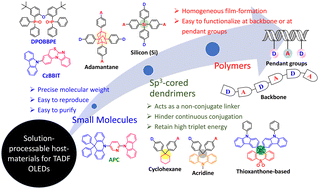
J. Mater. Chem. C, 2023,11, 13603-13624
https://doi.org/10.1039/D3TC02794E
Oxidative debris in graphene oxide: a decade of research
This review summarizes a decade of research on oxidative debris (ODs) in graphene oxide (GO) and discusses the protocols for isolating ODs, their structural characteristics, and their influence on several GO properties.

J. Mater. Chem. C, 2023,11, 12429-12452
https://doi.org/10.1039/D3TC02057F
Oxidative chemical vapor deposition for synthesis and processing of conjugated polymers: a critical review
Oxidative chemical vapor deposition (oCVD) has developed progressively in the last two decades as a solvent-free (or dry) methodology for synthesis and thin film deposition of conjugated polymers.

J. Mater. Chem. C, 2023,11, 11776-11802
https://doi.org/10.1039/D3TC01614E
Versatility of group VI layered metal chalcogenide thin films synthesized by solution-based deposition methods
This review summarizes major developments in various solution-based synthesis approaches and different applications such as supercapacitors, batteries, HER, and photocatalytic dye degradation of group VI layered metal dichalcogenide thin films.

J. Mater. Chem. C, 2023,11, 9768-9786
https://doi.org/10.1039/D3TC01470C
Recent advances in ecofriendly 2D monoelemental bismuthene as an emerging material for energy, catalysis and biomedical applications
Bismuthene exhibited potential application in electrochemical, optoelectronics, batteries, sensing, supercapacitors, photocatalytic and biomedical fields.

J. Mater. Chem. C, 2023,11, 6777-6799
https://doi.org/10.1039/D3TC00587A
Carbon-rich macrocycles and carbon nanoribbons as unique optical materials
Carbon-rich macrocycles and carbon nanoribbons act as unusual optical materials in the free form or when combined with other guests.
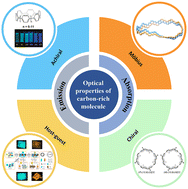
J. Mater. Chem. C, 2023,11, 4267-4287
https://doi.org/10.1039/D2TC05492B
Luminescent organic molecular frameworks from tetraphenylethylene-based building blocks
In this review, we mainly summarize the emerging luminescent organic molecular frameworks consisting of hydrogen bonded frameworks and supramolecular organic frameworks based on tetraphenylethylene building blocks.

J. Mater. Chem. C, 2023,11, 3675-3691
https://doi.org/10.1039/D2TC04713F
Review of photocathodes for electron beam sources in particle accelerators
This paper compares different photocathodes that are applicable for electron injector systems and summarizes the most important photocathode properties influencing the performance as an electron source.
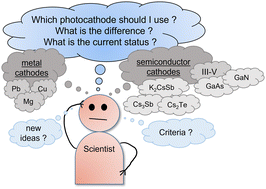
J. Mater. Chem. C, 2023,11, 3162-3179
https://doi.org/10.1039/D2TC03729G
Spintronic interactions between topological edge states in chiral carbon nanotubes: a natural helical symmetry approach
Single-wall carbon nanotubes (CNTs) possess topological edge states depending on the chiral indices and edge geometries.

J. Mater. Chem. C, 2023,11, 15001-15007
https://doi.org/10.1039/D3TC03029F
Ion exchange to construct a high-performance core–shell MnFe-PB@CuFe-PB cathode material for sodium ion batteries
A CuFe-PB coating film is formed via ion exchange on MnFe-PB, which effectively improves the structural stability and electrochemical performance of the sodium ion battery cathode material and inhibits Mn dissolution caused by the Jahn–Teller effect.

J. Mater. Chem. C, 2023,11, 9787-9793
https://doi.org/10.1039/D3TC00947E
Optimizing through-space interaction for singlet fission by using macrocyclic structures
A novel design idea of optimizing through-space interaction for intramolecular singlet fission is proposed by using macrocyclic structures.

J. Mater. Chem. C, 2023,11, 6856-6866
https://doi.org/10.1039/D3TC01077E
Improved stability of organic electrochemical transistor performance with a low swelling mixed conducting polymer: a comparative study with PEDOT:PSS
OECTs soaked in an electrolyte for up to 40 days produced with a low swelling mixed conductor, poly[3-(6-hydroxy)hexylthiophene] (P3HHT), showed enhanced stability in their electrochemical performance in comparison to PEDOT:PSS-based OECT.

J. Mater. Chem. C, 2023,11, 6296-6300
https://doi.org/10.1039/D3TC00108C
Tuning quantum capacitance in 2D graphene electrodes: the role of defects and charge carrier concentration
Electrochemical oxidation of a graphene monolayer results in a G-band shift in the micro-Raman spectrum and an increase in the quantum capacitance, resulting from an increase in the number and density of defects and charge carrier concentration in the graphene structure.

J. Mater. Chem. C, 2023,11, 6301-6305
https://doi.org/10.1039/D2TC04037A
A high linearity and energy-efficient artificial synaptic device based on scalable synthesized MoS2
Synaptic devices based on 2D materials are being considered as potential solutions to mimic the behavior of synapses in neuromorphic computing.

J. Mater. Chem. C, 2023,11, 5616-5624
https://doi.org/10.1039/D3TC00438D
Investigating magnetic van der Waals materials using data-driven approaches
In this work, we investigate magnetic monolayers of the form AiAiiB4X8 based on the well-known intrinsic topological magnetic van der Waals (vdW) material MnBi2Te4 (MBT) using first-principles calculations and machine learning techniques.

J. Mater. Chem. C, 2023,11, 5601-5610
https://doi.org/10.1039/D3TC00001J
Stretchable conductive hydrogels integrated with microelectronic devices for strain sensing
Conductive hydrogels have great potential for application in the field of flexible wearable devices due to their excellent stretchability and biocompatibility.

J. Mater. Chem. C, 2023,11, 15873-15880
https://doi.org/10.1039/D3TC02359A
A new method for rapid identification of traditional Chinese medicine based on a new silver sol: using the SERS spectrum for quality control of flavonoids and flavonoid glycosides in Potentilla discolor Bge.
The effectiveness of cesium ions as focusing agents in enhancing Raman signals of flavonoids is demonstrated. By using cesium ions, Potentilla discolor Bge. samples from ten origins are characterized, and an efficient method is proposed for identification of traditional Chinese medicines.

J. Mater. Chem. C, 2023,11, 15138-15148
https://doi.org/10.1039/D3TC02768F
Knotted fiber-based strain sensors with tunable sensitivity and a sensing region for monitoring wearable physiological signals and human motion
The knotted fiber-based strain sensor has tunable sensitivity and sensing region, making it suitable for monitoring wearable physiological signals and human motion with outstanding-comfort.

J. Mater. Chem. C, 2023,11, 14796-14804
https://doi.org/10.1039/D3TC01733H
Back in bismuth: controlling triplet energy transfer, phosphorescence, and radioluminescence via supramolecular interactions
Five bismuth-organic materials that exhibit fluorescence or phosphorescence and radioluminescence are reported, with the photophysical behavior dependent on both the identity of the outer sphere fluorophore and noncovalent interactions.

J. Mater. Chem. C, 2023,11, 14848-14864
https://doi.org/10.1039/D3TC02040A
High brightness and vibronic luminescent behavior of YAG:Mn4+/Ca2+ red phosphor for preparing phosphor-in-glass in white LED
Left figure shows PL spectra of phosphors with and without Ca2+ ion. The central images present the photos of PiG under illumination of sunlight and UV light. Right figures give EL spectra of LED encapsulated with different phosphors.

J. Mater. Chem. C, 2023,11, 14413-14420
https://doi.org/10.1039/D3TC03172A
Contact properties of a low-resistance aluminum-based electrode with metal capping layers in vertical oxide thin-film transistors
Vertical thin-film transistors (TFTs) with low contact resistance are necessary to realize high-resolution displays for virtual reality and augmented reality applications.

J. Mater. Chem. C, 2023,11, 14177-14186
https://doi.org/10.1039/D3TC02880A
Compositional engineering of ZnBr2-doped CsPbBr3 perovskite nanocrystals: insights into structure transformation, optical performance, and charge-carrier dynamics
ZnBr2 incorporated CsPbBr3 transformed into to Cs4PbBr6via the intermediate CsPbBr3/Cs4PbBr6 heterostructure, resulting in improved PL characteristics (near unity PLQY).

J. Mater. Chem. C, 2023,11, 14248-14259
https://doi.org/10.1039/D3TC02179C
A morphological study of random nanostructured external light extraction layers for enhancing optical characteristics of OLEDs
This study presents an in-depth investigation of nano-pillar-based external light extraction techniques, focusing on the analysis of light extraction characteristics based on the pillar and plane structures.

J. Mater. Chem. C, 2023,11, 14307-14315
https://doi.org/10.1039/D3TC02334F
High-performing TiO2 flower-like nanostructures based on flexible MWCNTs for dual-band terahertz absorption
In THz science and technology, nanostructures play a vital role in the development of devices based on electronics and photonics.

J. Mater. Chem. C, 2023,11, 14199-14206
https://doi.org/10.1039/D3TC01244A
Unrevealing the opto-structural features of luminescent polymeric films containing EuIII-doped phosphors through spectroscopic and theoretical perspectives
Evaluating opto-structural correlations to tailor the luminescence of polymeric films based on EuIII-doped phosphors using a new combined spectroscopic and theoretical protocol.

J. Mater. Chem. C, 2023,11, 14226-14236
https://doi.org/10.1039/D3TC02269B
The impact of dendrite morphology on the optical properties of sunflower mimic plasmonic metasurfaces
Light polarization and morphological features of sunflower mimic plasmonic metasurfaces i.e., dendrite shape, aspect ratio and packing density govern the distribution of enhanced electric field and plasmonic hot spots on their surface.

J. Mater. Chem. C, 2023,11, 14088-14096
https://doi.org/10.1039/D3TC02544F
Positive aging in InP-based QD-LEDs encapsulated with epoxy: the role of thiol molecules and post-annealing treatment
The diffusion of thiol molecules present in epoxy resin promotes positive aging in InP-based QD-LEDs. Subsequent annealing treatment enable thiol molecules migration into lower layers, leading to a remarkable performance enhancement.

J. Mater. Chem. C, 2023,11, 14292-14298
https://doi.org/10.1039/D3TC02098C
A green catalyst and sensor: band engineering of Bi2Fe4O9-based S-scheme p–n/n homo-heterojunction for detection and degradation of cytotoxic drug
Practically viable Bi2Fe4O9-based calcium-packed homo-heterojunction for detection and oxidative removal of pharmaceutical waste; a step towards clean water and zero waste.

J. Mater. Chem. C, 2023,11, 14260-14277
https://doi.org/10.1039/D3TC02021E
Surface chemical mechanisms of trimethyl aluminum in atomic layer deposition of AlN
Two different pathways for decomposition of adsorbed trimethyl aluminum in the ALD of AlN have been investigated by computation chemistry. The two pathways give different saturation coverage and thus growth per cycle.

J. Mater. Chem. C, 2023,11, 13935-13945
https://doi.org/10.1039/D3TC02328A
Gate-tunable rectification and photoresponse in a MoTe2/SnS2 van der Waals heterostructure based P–N diode
The p–n junction, one of the prominent electrical components capable of being utilized in electronics and optoelectronics, has attracted renewed interest due to recent research in two-dimensional (2D) materials.

J. Mater. Chem. C, 2023,11, 13981-13990
https://doi.org/10.1039/D3TC01990J
High-performance UV-Vis-NIR photomultiplier detectors assisted by interfacial trapped-electrons
A photomultiplication-type YZ-PD with excellent photodetection performance in the UV–Vis–NIR region was successfully constructed using a bulk heterojunction strategy.

J. Mater. Chem. C, 2023,11, 13971-13980
https://doi.org/10.1039/D3TC02564K
Solvatochromic and aggregation-induced emission active nitrophenyl-substituted pyrrolidinone-fused-1,2-azaborine with a pre-twisted molecular geometry
First reported observation of aggregation-induced emission and solvatochromism in a polycyclic donor–acceptor fluorophore with a BN-substitution.

J. Mater. Chem. C, 2023,11, 13740-13751
https://doi.org/10.1039/D3TC03278G
Effect of interfacial SiO2 layer thickness on the memory performances in the HfAlOx-based ferroelectric tunnel junction for a neuromorphic system
In recent years, research on ferroelectric materials based on hafnium oxide has increased because of promising advantages such as fast operating speeds and CMOS process compatibility.

J. Mater. Chem. C, 2023,11, 13886-13896
https://doi.org/10.1039/D3TC02137H
Insights into luminescence thermal quenching of Mn4+-doped BaLa(Na/Li)(W/Te)O6 double perovskite red phosphors
A series of Mn4+ doped BaLa(Na/Li)WO6 and BaLaLi(W/Te)O6 phosphors were synthesized and studied. Substitution reactions of Na+ by Li+ and W6+ by Te6+ allows the management of the energy gap between Mn4+ 2Eg and 4T2g states and improves the thermal stability of the phosphors.

J. Mater. Chem. C, 2023,11, 13865-13873
https://doi.org/10.1039/D3TC02216A
Phenothiazine-based donor–acceptor covalent–organic frameworks with keto–enol irreversible tautomerism as a promising third-order nonlinear optics material
Keto–enol tautomerization endowed TFP-TZ with more D–A interaction strengths and an electron-withdrawing C![[double bond, length as m-dash]](https://www.rsc.org/images/entities/char_e001.gif) O group in the keto form facilitated charge transfer.
O group in the keto form facilitated charge transfer.

J. Mater. Chem. C, 2023,11, 13897-13904
https://doi.org/10.1039/D3TC02303F
Dual conductive network sensors based on an MXene/PDES supramolecular elastomer and their performance
A dual conductive network strain sensor was prepared by simple UV-curing of a mixture of MXene and polymerizable deep eutectic solvent. This sensor had high-strength, while maintained the self-healing, anti-freezing, and high-adhesion features.

J. Mater. Chem. C, 2023,11, 13874-13885
https://doi.org/10.1039/D3TC02890A
Lightweight polyimide-derived carbon foams with anisotropic porous structures prepared by microwave-assisted foaming and carbonization for thermal insulation and EMI shielding applications
Herein, a facile strategy was proposed to fabricate lightweight polyimide-derived carbon foams (PICFs) with anisotropic pore structures which possess multifunctional properties enabling potential applications in high-end engineering sectors.

J. Mater. Chem. C, 2023,11, 13446-13458
https://doi.org/10.1039/D3TC02404K
Impacts of PbI2 on high-efficiency perovskite solar cells: exploring intercalation orientations and defects
The parallel and vertical intercalations of the layered PbI2 in CsPbI3 result in type-I and type-II band alignments, respectively. The deep-level states caused by certain defects in PbI2 are not active recombination centers.
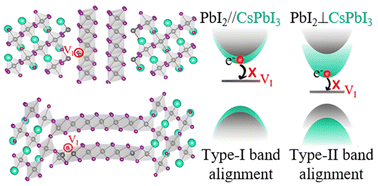
J. Mater. Chem. C, 2023,11, 13281-13289
https://doi.org/10.1039/D3TC02770H
High efficiency flexible PEDOT:PSS/silicon hybrid heterojunction solar cells by employing simple chemical approaches
Efficient flexible hybrid solar cells with basic device architecture are demonstrated using the low-cost Si wafers via simple chemical approaches, and may lead to the next-generation flexible optoelectronic applications with 4-fold reduced Si usage.

J. Mater. Chem. C, 2023,11, 13488-13502
https://doi.org/10.1039/D3TC02236F
A thermally etched N-doped porous layered silicon anode for improved cycling stability of lithium-ion batteries
A N-doped porous layered silicon anode based on a thermally etched method of metal oxides (Fe) for superior electrochemical performance with 89.6% capacity retention after 500 cycles at 2 A g−1.

J. Mater. Chem. C, 2023,11, 13466-13475
https://doi.org/10.1039/D3TC02218H
From aggregation-caused quenching to aggregation-induced delayed fluorescence: the impact of the effect of substituents
The electroluminescent mechanism of four imidazole-based luminogens are explored. Results show that introducing different substituents can change the molecules from aggregation-caused quenching to aggregation-induced delayed fluorescence.

J. Mater. Chem. C, 2023,11, 13403-13417
https://doi.org/10.1039/D3TC02542J
A moldable PEDOT:PSS dry electrode with excellent epidermal compliance for wearable electrocardiogram monitoring
An aerogel dry electrode was prepared by an interesting foaming process. The resultant aerogel displayed impressive microscale shape moldability, enabling excellent skin compliance for high-quality ECG signal detection.

J. Mater. Chem. C, 2023,11, 13387-13394
https://doi.org/10.1039/D3TC01988H
Microwave-plasma induced one-step synthesis of Ni(PO3)2 nanosphere-loaded bio-waste derived N, P co-doped carbon for an asymmetric supercapacitor with prolonged life
Ni(PO3)2 nanospheres and bio-waste derived N, P co-doped carbon composites as asymmetric supercapacitor with long cycle life to run an oximeter and 28 LEDs demonstrating a strong practical application prospect.

J. Mater. Chem. C, 2023,11, 13503-13517
https://doi.org/10.1039/D3TC02074F
Textile-based electrophoretic electronic paper displays with machine-washable, tailorable, and thermostatic functions for truly wearable displays
The textile-based electrophoretic display has been created and exhibited high contrast ratio, a low voltage, and good stability. The static display clothing and a dynamic display wristband watch show the potential for truly wearable displays.

J. Mater. Chem. C, 2023,11, 13244-13255
https://doi.org/10.1039/D3TC01412F
A near-infrared photoelectrochromic device with indoor thermal management for self-powered smart windows
A near-infrared photoelectrochromic device (NIR-PECD) is a combination of a dye-sensitized solar cell (DSSC) and an electrochromic device (ECD) that directly generates transmittance contrast in IR region from solar radiation without an additional power source.

J. Mater. Chem. C, 2023,11, 13290-13299
https://doi.org/10.1039/D3TC01669B
A hydrogen-bonded organic framework of rigidly branched fluorophore: guest-adaptive cavity and phase-dependent light emission
A non-covalent assembly of a highly branched molecule produces porous crystals supported only by weak interactions. This flexible network shows reversible morphological changes and displays fluorescence responses to external stimuli and guest uptake.

J. Mater. Chem. C, 2023,11, 12933-12940
https://doi.org/10.1039/D3TC01826A
A multifunctional coumarin-based probe for distinguishable detection of Cu2+ and Zn2+: its piezochromic, viscochromic and AIE behavior with real sample analysis and bio-imaging applications
A multifunctional coumarin based organic luminophore, CTH, has been synthesized and its fluorescence properties are investigated.

J. Mater. Chem. C, 2023,11, 13056-13066
https://doi.org/10.1039/D3TC02554C
Rapid, solvent-minimized and sustainable access to various types of ferroelectric-fluid molecules by harnessing mechano-chemical technology
Our study showcases the noteworthy impact of mechanochemical technology on the synthesis of liquid crystalline molecules. Particularly, this approach offers the rapidly/sustainably creation of the ferroelectric-fluid (NF/SmAF) molecular libraries.
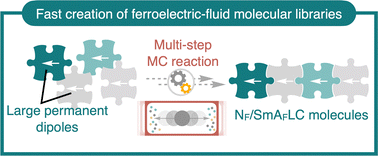
J. Mater. Chem. C, 2023,11, 12525-12542
https://doi.org/10.1039/D3TC02212A
Chiral and conductive viologen-based supramolecular gels exhibiting tunable charge-transfer properties
Robust, transparent, conductive, redox-active and chiral gels are obtained by self-assembly of a cholesterol-substituted 4,4′-bipyridinium. Self-organization gives chiral hollow core–shell cylinders of inner radius 5.2 nm and shell thickness 2.6 nm.

J. Mater. Chem. C, 2023,11, 12764-12775
https://doi.org/10.1039/D3TC02076B
In situ preparation of ultrastable and flexible BA2PbBr4 nanocrystal films for X-ray imaging
The ultrastable and flexible BA2PbBr4 NC@PMMA film, which was fabricated by using an in situ fabrication method, has achieved X-ray imaging for planar and nonplanar objects with a high spatial resolution of 5.5 lp mm−1.

J. Mater. Chem. C, 2023,11, 12759-12763
https://doi.org/10.1039/D3TC02083E
Improved performance for polymer solar cells though photon energy harvesting and down-conversion of Eu3+-induced diblock polymer aggregates (EIPAs)
Eu3+-induced diblock polymer aggregates (EIPAs) were synthesized by self-assembly method and doped into the active layer of various non-fullerene systems to improve the power conversion efficiency (PCE) and stability of the devices.

J. Mater. Chem. C, 2023,11, 12730-12739
https://doi.org/10.1039/D3TC01975F
Guiding charge injection in Schottky-barrier transistors through the spatial Fermi-level gradients of heterogeneous bimetallic systems
A heterogeneous bimetallic system, composed of two metallic thin films with inherently different Fermi levels, is potentially usable for the fine tuning of interfacial charge dynamics.

J. Mater. Chem. C, 2023,11, 12675-12684
https://doi.org/10.1039/D3TC02561F
Interfacial modification via aniline molecules with multiple active sites for performance enhancement of n–i–p perovskite solar cells
The ANE molecule has a chemical interaction with the perovskite and SnO2 film, both reducing the oxygen vacancy defects in the SnO2 film and passivating the uncoordinated Pb2+, significantly reducing the interface defects and effectively suppressing the non-radiative recombination.

J. Mater. Chem. C, 2023,11, 12750-12758
https://doi.org/10.1039/D3TC02144K
Photoluminescence spectroscopy of dibenzopentacene single-crystals: multiple emissive states across temperature, time, and magnetic field in a pursuit of exothermic singlet fission
A photoluminescence study of dibenzopentacene single crystals at different temperatures, magnetic fields, and time scales shows complex evolution of excitation and the presence of singlet fission.
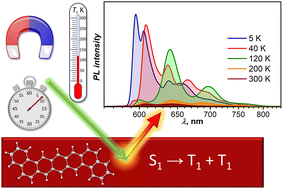
J. Mater. Chem. C, 2023,11, 12714-12729
https://doi.org/10.1039/D3TC01548C
Particle size effect on the microstructure and the aging process of flash-sintered barium titanate from micro and nanopowders
Flash sintering experiments on different-sized BTO powders are performed, and the influence of the conditions over the achieved microstructures and functional properties is shown. For smaller powder sizes a time instability of properties is revealed.

J. Mater. Chem. C, 2023,11, 12740-12749
https://doi.org/10.1039/D3TC02143B
Recyclable EGaIn/TPU sheath–core fibres for superelastic electronics and sensing applications
The prepared TET fibre exhibits excellent strain sensing performances and can also be deformed into stretchable helical wire, even being recycled and reused.

J. Mater. Chem. C, 2023,11, 12163-12173
https://doi.org/10.1039/D3TC02393A
Molecular properties controlling chirality transfer to halide perovskite: computational insights
Computationally investigate chirality transfer effect from chiral ligands bound to the surface of a lead-halide perovskite nanomaterial. By changing the molecular polarity of the chiral molecules, the chirality of the system can be tuned.
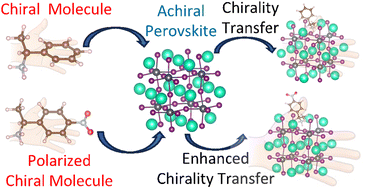
J. Mater. Chem. C, 2023,11, 12374-12383
https://doi.org/10.1039/D3TC02248J
A plasmonic hetero-structure using charge transfer effect improved LSPR for enhanced up-conversion luminescence
A composite heterostructure of Au/D-MoS2 has been designed for a charge transfer LSPR modulator for enhanced upconversion luminescence.

J. Mater. Chem. C, 2023,11, 12337-12347
https://doi.org/10.1039/D3TC02081A
Orientation preference control: a novel approach for tailoring molecular electronic functionalities
Orientation preference control: molecules transitioning from a mixture of foot-standing and hand-standing to exclusively foot-standing.

J. Mater. Chem. C, 2023,11, 12348-12355
https://doi.org/10.1039/D3TC02838K
Controllable and tuneable growth of NaYbF4:Tm(0.5%)Fe(5%)@Na(Yb/Y)F4-core@shell structures and the effect of their geometry on upconversion luminescence
Controllable and tuneable core@shell UCNPs with enhanced UC efficiency through varied energy transfer pathways arising from geometric alteration.

J. Mater. Chem. C, 2023,11, 12356-12363
https://doi.org/10.1039/D3TC01215H
The role of solvents in the microstructure and charge transport of semiconducting polymer films prepared at the air–liquid interface
Fabricating devices using floating films of semiconducting polymers offers many advantages. In floating films, a judicious selection of solvents is essential to achieve maximum device performance based on the nature of the semiconducting polymer.

J. Mater. Chem. C, 2023,11, 12364-12373
https://doi.org/10.1039/D3TC02282J
A PA66 lamellar crystal film with excellent triboelectric performance in vertical contact separation mode
Triboelectric nanogenerators (TENGs) are gaining tremendous attention as an environmentally friendly technology that converts low-frequency mechanical energy into electrical energy.

J. Mater. Chem. C, 2023,11, 12222-12233
https://doi.org/10.1039/D3TC02258G
Polysulfide polyurethane–urea-based dielectric composites with CeO2-loaded MXene exhibiting high self-healing efficiency
We developed a CeO2@MXene/PSPU composite film with a dielectric constant of 206 at 100 Hz, a loss of 0.19 and a self-healing efficiency of 97.9% at a filler content of 5.25 vol%.

J. Mater. Chem. C, 2023,11, 12261-12269
https://doi.org/10.1039/D3TC02101G
Enhanced stability and ultrahigh proton conductivity of hydrogen-bonded organic frameworks
A highly stable HOF-based composite (HDSD-1@Tp) was obtained by in situ reaction with HDSD-1. The introduction of NH4+ optimizes its proton conduction pathways, making HDSD-1@Tp-NH3 possess a high proton conductivity of 3.8 × 10−1 S cm−1.

J. Mater. Chem. C, 2023,11, 12206-12212
https://doi.org/10.1039/D3TC02090H
Triplet conformation in chromophore-fused cyclooctatetraene dyes
Cyclooctatetraene (COT) is predicted to have a planar aromatic triplet state. Using femtosecond-to-microsecond transient absorption spectroscopy, we show that acene chromophore-fused COT dyes also have a planar COT ring in their triplet states, although they are not aromatic.
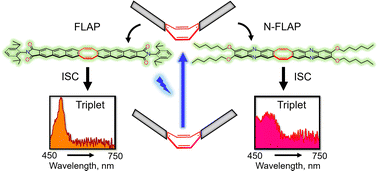
J. Mater. Chem. C, 2023,11, 12243-12253
https://doi.org/10.1039/D3TC02151C
Chemical states and local structure in Cu-deficient CuxInSe∼2 thin films: insights into engineering and bandgap narrowing
Cu deficiency alters the local structure of the Cu–Se–In tetrahedral network thereby reducing the bandgap in CuInSe2.

J. Mater. Chem. C, 2023,11, 12016-12028
https://doi.org/10.1039/D3TC02135A
About this collection
2023 marked the 10th anniversary year of the Journal of Materials Chemistry A, B and C. To celebrate, we have highlighted some of the authors who have published for the first time in these journals during the anniversary year.
This collection showcases a selection of articles that have been published by corresponding authors for the first time in Journal of Materials Chemistry C in 2023.
Thank you to these authors for choosing to publish with the journal!
Check out these companion collections: